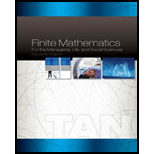
Suppose you are given the linear programming problem.
Minimize
Subject to
Give the associated standard maximization problem that you would use to solve this linear programming problem via the simplex method.
Want to see the full answer?
Check out a sample textbook solution
Chapter 4 Solutions
Finite Mathematics for the Managerial, Life, and Social Sciences, 11th Edition
- (a) For the following linear programme, sketch the feasible region and the direction of the objective function. Use you sketch to find an optimal solution to the program. State the optimal solution and give the objective value for this solution. maximize +22 subject to 1 + 2x2 ≤ 4, 1 +3x2 ≤ 12, x1, x2 ≥0 (b) For the following linear programme, sketch the feasible region and the direction of the objective function. Explain, making reference to your sketch, why this linear programme is unbounded. maximize ₁+%2 subject to -2x1 + x2 ≤ 4, x1 - 2x2 ≤4, x1 + x2 ≥ 7, x1,x20 Give any feasible solution to the linear programme for which the objective value is 40 (you do not need to justify your answer).arrow_forwardfind the domain of the function f(x)arrow_forwardFor each of the following functions, find the Taylor Series about the indicated center and also determine the interval of convergence for the series. 1. f(x) = ex-2, c = 2 Π == 2. f(x) = sin(x), c = 2arrow_forward
- QUESTION 5. Show that if 0 ≤r≤n, then r+2 r r (c) + (+³) + (+³) +- + (*) -(+) n n+ = r (1)...using induction on n. (2) ...using a combinatorial proof.arrow_forwardUse a power series to approximate each of the following to within 3 decimal places: 1. arctan 2. In (1.01)arrow_forwardFor each of the following power series, find the interval of convergence and the radius of convergence: n² 1.0 (x + 1)" n=1 շո 3n 2. Σ n=1 (x-3)n n3arrow_forward
- Use a known series to find a power series in x that has the given function as its sum: 1. xcos(x³) 2. In (1+x) xarrow_forwardif n is odd integer then 4 does not divide narrow_forwardor W Annuities L Question 2, 5.3.7 > Find the future value for the ordinary annuity with the given payment and interest rate. PMT = $2,000; 1.65% compounded quarterly for 11 years. The future value of the ordinary annuity is $ (Do not round until the final answer. Then round to the nearest cent as needed.) example Get more help Q Search 30 Larrow_forward
- Find the cdf of a random variable Y whose pdf is given by; 2, 0≤x≤1 1/3, 0≤x≤1 a) f(x)=3, 2≤x≤4 0, elsewhere 2, 1≤x≤2 b) f(x)= (3-x)2, 2≤x≤3 0, elsewherearrow_forwardFor all integers a and b, a + b is not ≡ 0(mod n) if and only if a is not ≡ 0(mod n)a or is not b ≡ 0(mod n). Is conjecture true or false?why?arrow_forwardor W Annuities L Question 2, 5.3.7 > Find the future value for the ordinary annuity with the given payment and interest rate. PMT = $2,000; 1.65% compounded quarterly for 11 years. The future value of the ordinary annuity is $ (Do not round until the final answer. Then round to the nearest cent as needed.) example Get more help Q Search 30 Larrow_forward
 College Algebra (MindTap Course List)AlgebraISBN:9781305652231Author:R. David Gustafson, Jeff HughesPublisher:Cengage Learning
College Algebra (MindTap Course List)AlgebraISBN:9781305652231Author:R. David Gustafson, Jeff HughesPublisher:Cengage Learning Algebra for College StudentsAlgebraISBN:9781285195780Author:Jerome E. Kaufmann, Karen L. SchwittersPublisher:Cengage Learning
Algebra for College StudentsAlgebraISBN:9781285195780Author:Jerome E. Kaufmann, Karen L. SchwittersPublisher:Cengage Learning Glencoe Algebra 1, Student Edition, 9780079039897...AlgebraISBN:9780079039897Author:CarterPublisher:McGraw Hill
Glencoe Algebra 1, Student Edition, 9780079039897...AlgebraISBN:9780079039897Author:CarterPublisher:McGraw Hill Elementary Linear Algebra (MindTap Course List)AlgebraISBN:9781305658004Author:Ron LarsonPublisher:Cengage Learning
Elementary Linear Algebra (MindTap Course List)AlgebraISBN:9781305658004Author:Ron LarsonPublisher:Cengage Learning



